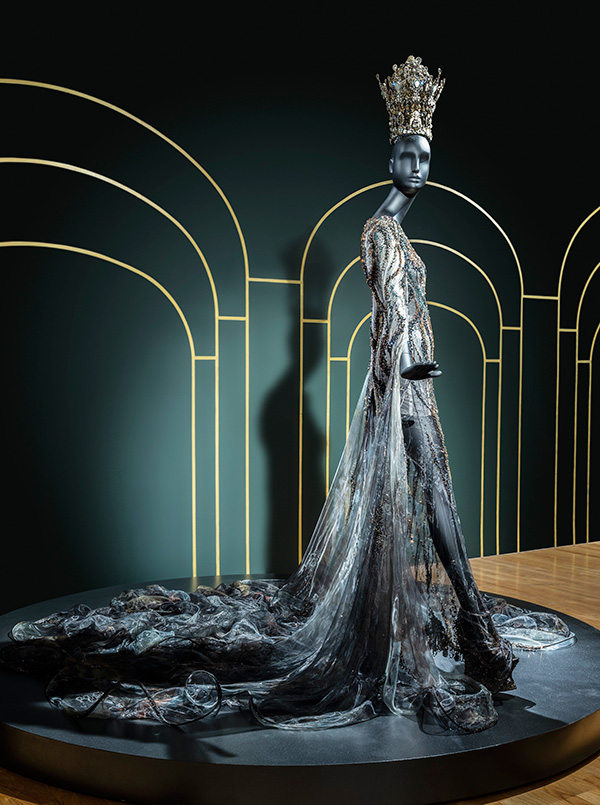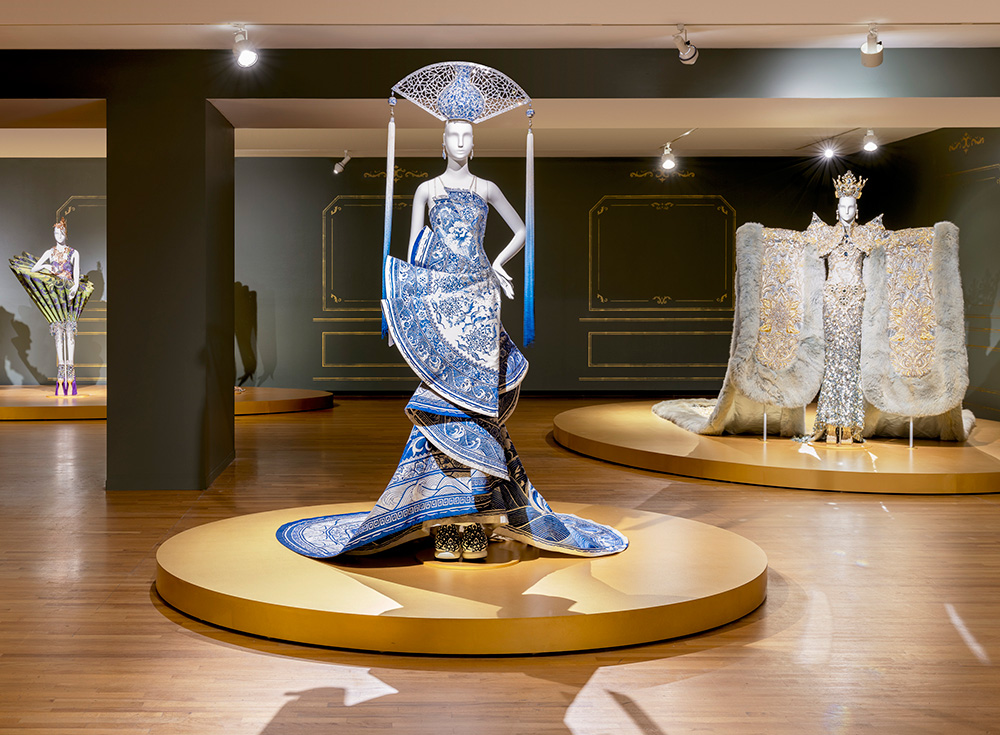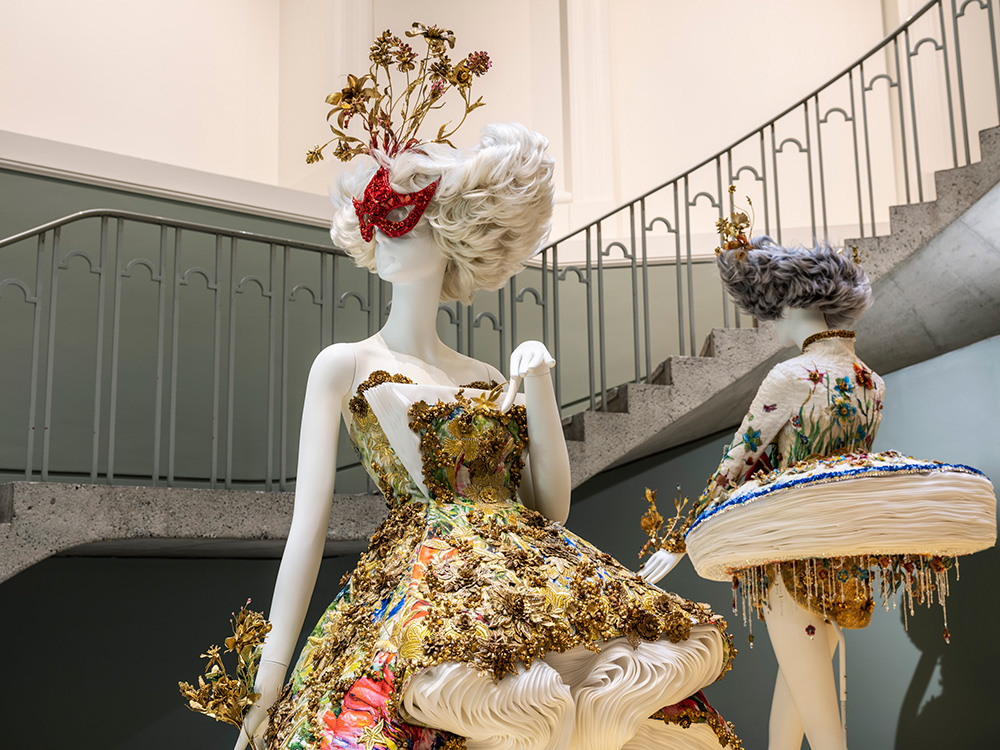Fashion often gets a bad rap. And by that I don’t mean a misplaced scarf or a poorly accessorized cape.
I mean people think it’s stupid.
Certainly fashion can be frivolous stuff, light as air and just as apt to blow away, but it’s also embedded with culture, identity, history and, of course money. Lots of money.
The global fashion industry accounted for almost $3 trillion in 2018. Stoking the engines of desire requires the constant application of media heat and pressure, so it’s little wonder that the fashion world has a reputation for cutthroat viciousness. The Devil eats Prada may be a more apt descriptor.
In this globally carnivorous culture Guo Pei is a relative newcomer. Although she has been designing clothes for 30 years, the designer came to worldwide attention riding the coattails of Rihanna, who wore Guo’s yolk-coloured dress to the 2015 Met Ball in New York City.
Weighing in at 25 kilograms with a 16-foot train and most likely the sacrifice of an entire family of foxes, the designer’s most famous creation required the help of three people to help Rihanna move around. But the eggy confection proved a sensation, and a fashion star was born.
The gown occupies pride of place in the Vancouver Art Gallery’s new exhibition Guo Pei: Couture Beyond, a collection of work spanning the length of Guo’s career in haute couture and as the title indicates Beyond! This does not mean the woman is being shot into space like some especially fabulous cosmonaut, but rather that her work has leapt off the runway and landed in galleries and museums, as well as the backs of extremely wealthy people.
My son Louis, obsessed with all things stylish, trotted off to see the show and immediately termed it, “A big fucking flex.”
“What does that mean?” I asked.
“It’s showing off,” he said.
The boy is right on the money. These are not really clothes to be worn by ordinary people doing regular things like walking, bending over or attempting to sit down. They are creations for people who can afford to have a retinue of helpers to lift their cape and support them as they totter along the pebbled paths of Versailles. They are meant to stun, dazzle and overwhelm. The collection of garments are so encrusted and over-embellished that they resemble some form of undersea life, or a fretwork of lichen made of golden thread and studded with Swarovski crystals.
If you approach the work from a costume or theatrical angle it makes more sense. But as Louis rightfully indicated, it is designed to show off what the designer and her atelier Rose Studio are capable of. It’s impressive but also a little goofy, not unlike watching a muscle-bound bodybuilder pop out every oiled sinew. Part of you may think, “Oh my,” while another part thinks, “Gross!”
This is the Vancouver Art Gallery’s first entrée into the world of fashion exhibition, following on the heels of wildly successful shows at the Met in New York dedicated to the work of Alexander McQueen and Rei Kawakubo. Guo Pei was on hand to open her collection and offer an onstage interview with fashion journalist Bronwyn Cosgrave. In person Guo is small, with a shiny bob and a constant smile. The interview was gentle, with the attending press lobbing softballs and the designer (through a translator) providing the expected responses.
But another side of Guo is on display in Pietra Brettkelly’s documentary Yellow Is Forbidden which played recently at the Vancouver International Film Festival. While Yellow Is Forbidden pales in comparison to the number of fascinating films about fashion folk including Alexander McQueen and André Leon Talley, some interesting stuff sneaks through.
“I’m not a nation, I’m a person,” Guo says in the beginning of the film. But her work is held up as point of national pride. In an era where luxury goods from the West aren’t quite so cool with the ruling powers any longer, Guo is a smiling cheerleader for a new China. The film depicts her as an underdog in the icy climes of haute couture, but it isn’t quite that simple. With China poised to topple the U.S. as the reigning global superpower, and the yuan set to replace the dollar for buying Saudi oil, Guo’s ascendance comes at an interesting moment.
The Vancouver Art Gallery show also comes at an odd time in Vancouver. High fashion has staked a claim on large sections of the city’s downtown core, now termed the Luxury Zone. Stores are clustered thick and fast on Alberni Street in a veritable oyster bed of high-end brands, including YSL, Hermès, Gucci, Escada and Burberry, all rooting like truffle pigs for top dollar. And the luxury trend continues to expand across the city.
Indeed, it seems a global arms race to see who can sport the most luxurious brands. On a recent trip to Paris I noticed that the lineups for goods by Chanel or Goyard were around the block. The luxury market in China has also exploded. A recent global market study by Bain “estimated that by 2020, China will overtake the United States and Japan as the world’s largest luxury market. In 2017 alone, local buying by Chinese customers boosted sales in Mainland China by a remarkable 15 per cent to a total market size of US$23.8 billion.”
Fashion of this scale recalls other empires of old and images of Marie Antoinette stuffing down cake while bedecked in a mille-feuille of crinoline and lace. Meanwhile, the whiff of imperial privilege coupled with the levels of economic disparity in Vancouver has reached a new threshold of extremity and occasionally feels like it might tip over into outright class warfare.
But what do a few fancy dresses have to do with the idea of revolution in the streets? It’s just silly old fashion after all, although it is interesting that Guo’s Paris fashion show took place at La Conciergerie, where Marie Antoinette was imprisoned before her final rendezvous with Madame Guillotine.
‘I’m not a feminist’
Clothing has always been one of the most immediate indicators of status, wealth and class. But there is something even more critical to examine in the Vancouver Art Gallery’s Guo Pei exhibition, namely gender.
In an expansive New Yorker profile the designer pulled no punches about her feelings on what she considered to be feminine. “Her grandmother’s bound feet didn’t repel her. An upper-class woman would have been proud to hobble on her “flowerpot-sole shoes” — embroidered slippers on tall pedestals — and Guo pays homage to them in vertiginous chopines that are lashed to the ankles with satin ribbons. ‘I’m not a feminist,” she said emphatically. ‘I think women should be like water: it looks soft and tender, but it’s very powerful.’”

Anyone who has ever attempted to walk in high heels for a day knows full well the pain entailed, and it’s difficult to look at some of the dresses and shoes on display at the VAG and not feel a shudder run down your spine. This is not power; it is its exact opposite. In a telling moment in Yellow Is Forbidden, models stagger and crumple under the heft of the garments they’re wearing. In the first showing of Guo’s famous yellow gown, the model was forced to stop in the middle of the runway, unable to move forward. As the designer prepares for her show in Paris she’s informed that under French law workers are only allowed to carry a certain weight, although Guo’s dresses often weigh more than the models who wear them. What is meant to be stunning and beautiful simply looks agonizing as the models inch down the runway in vertiginous shoes or walk blindly in massive headpieces.
It is hard to imagine any young and active woman wanting to be encased, mummified inside a garment that requires helpers to move around. In this Guo’s work harkens back to Imperial China when hierarchies of dress were strictly maintained and the practice of foot binding was meant to demonstrate status, wealth and privilege. A noble woman with lotus feet was an object of erotic languor, unable to work and entirely dependent on others. If you cannot move freely, breathe deeply or walk unassisted, how much power do you really have over your own life?
Many of the dresses on display at the Vancouver Art Gallery wouldn’t look out of place in Dior’s New Look, a collection and silhouette (nipped in waists, enormous skirts) that heralded the return of women to a strictly ornamental role in post-war society. Guo cites the influence of designer Cristóbal Balenciaga’s 1950s work, an Eisenhower era when a woman’s place was back in the kitchen. Hers is a retrograde version of fashion that lacks the intellectual rigour of Rei Kawakubo, the wit of an Elsa Schiaparelli, or the street cred of Raf Simons. Most often it simply feels overworked, overwrought and ponderous. Unlike other more radical designers who move easily in gender fluid waters, Guo is resolutely old-fashioned about gender roles. Women are required to look like they’re wearing the adult equivalent of pinafores.
Guo maintains a loyalty to the current ruling elite, both financial and political. In one scene in Brettkelly’s film, a journalist pointedly asks the designer about dressing “wives of public figures, princelings, and leaders of the Communist party.” The designer’s smile turns forced as she maintains that things are different and that the bad people have been purged in anti-corruption crackdowns and replaced by regular customers. As if on cue the film supplies this new potential clientele at a glittering political party in the U.S., presided over by Wendi Deng Murdoch (ex-wife of Rupert Murdoch). Guo is seated next to Donald Trump and his wife Melania, as the former Mrs. Murdoch remarks that perhaps the FLOTUS can wear Guo’s designs in the future. It is hard not to flash to Melania Trumps’s many horrific fashion moments this past year, from dressing like a Nazi-collaborator, a colonialist or flashing a jacket that informs the entire world, “I Really Don’t Care, Do U?” while on her way to visit migrant children.
Fashion is a business and Guo is very much a businesswoman. In one of the more unvarnished scenes in Yellow Is Forbidden she is captured giving her team of seamstresses a load of pure shit about working faster and cheaper. In the New Yorker profile she is quoted saying: “My generation is the most patriotic, because during our lifetime we have seen such an increase in prosperity,” she said. “I really don’t care about ideology, or who’s in power, as long as the economy keeps growing.”

Imperial grandeur
What women wear has always been a source of ongoing fascination, from the sexual history of shoes to the ongoing obsession with yoga pants. Lady Gaga made something of a minor fashion moment this month when she arrived to give a speech about women in Hollywood in an oversized brown suit. In her talk, Gaga spoke about trying on various corsets, gowns and heels, only to feel sick to her stomach. Femininity has always been something of a performance, as Gaga knows only too well.
But many of the most influential female designers came to fame by cutting the strings and constraints of women’s clothing, effectively liberating them from the immobilizing forces of corsets and hoop skirts, from Chanel to Comme des Garçons. Dressing as a woman shouldn’t feel like having to put on a costume, but that is exactly what the Vancouver Art Gallery show is about.
In a city like Vancouver, where you have to step over homeless people on your way to the Chanel store, it must be asked whether an exhibition that celebrates such insane excess is right or even appropriate. And I say this as someone who likes and follows fashion.
As Guo said at the press conference, she is not much interested in dressing celebrities and believes her work is better suited for museums and galleries, where in a few hundred years people from the future may marvel at the clothing of late capitalism, perhaps in the same fashion that we marvel at the giddy heights of aristocratic ages of old.
But as history indicates, imperial grandeur has a habit of ending badly. Things didn’t work out well for the French aristocracy, nor did the Qing Dynasty end happily. As Guo says at the end of the Yellow Is Forbidden, “I am my own empress.” Which begs the question — do we really need another one of those? ![]()
Read more: Media
















Tyee Commenting Guidelines
Comments that violate guidelines risk being deleted, and violations may result in a temporary or permanent user ban. Maintain the spirit of good conversation to stay in the discussion.
*Please note The Tyee is not a forum for spreading misinformation about COVID-19, denying its existence or minimizing its risk to public health.
Do:
Do not: